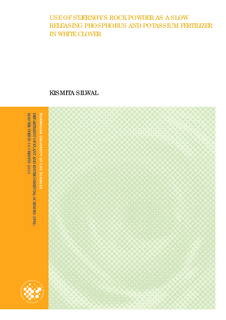| dc.contributor.author | Silwal, Kismita | |
| dc.date.accessioned | 2013-08-05T09:10:35Z | |
| dc.date.available | 2013-08-05T09:10:35Z | |
| dc.date.copyright | 2013 | |
| dc.date.issued | 2013-08-05 | |
| dc.identifier.uri | http://hdl.handle.net/11250/189569 | |
| dc.description.abstract | Plant availability of K and P from biotite and apatite present in the carbonatite rock
formation of Stjernøy, was investigated in a pot experiment with white clover. The pot
experiment consisted of nine different treatments that included apatite and biotite alone or
in combination with chemical fertilizers, lime alone or in combination with PK- fertilizer
and PK-fertilizer alone, all added to a low fertility sandy soil. Each treatment had four pot
replicates and four subsequent herbage cuts and stolons were sampled. Dry matter yield,
concentrations and uptake of K, P and other elements in the herbage and stolons was
analysed. Plants were grown in an artificially lighted growth chamber in Jord laboratory,
UMB, Norway.
All treatments with rock application maintained high K concentration (> 25 g kg-
1DM) in the herbage. Application of rock powder with a full dose PK-fetilizer gave highest
total yield (23.1 g pot-1), highest total K-uptake (769 mg pot-1), and higher uptake of Mg
and Ca than rock alone. This study concludes that biotite releases K at rate that easily
matches requirements by plants. On the other hand P bounded in magmatic apatite was
not taken up by plant, and the presence of carbonatite reduced the availability of P present
in the soil or added as soluble fertilizer in the sandy soil with low buffering ability. All
plants receiving P fertilizer had significantly higher DM yield and improved K uptake
compared to similar treatments without soluble P. This biotite carbonatite rock used alone
as a fertilizer is not feasible for plant production. It was also found that plants easily
absorbed nutrients from the applied fast-released soluble salts with no longer effect on
plant availability. Further investigation needs special knowledge on mineral weathering
processes and soil reactions especially enhancing P solubility for better understanding the
potentiality of applied carbonatite rocks, relationship between nutrients released and plant
uptake. | no_NO |
| dc.language.iso | eng | no_NO |
| dc.publisher | Norwegian University of Life Sciences, Ås | |
| dc.title | Use of Stjernøy's rock powder as a slow releasing phosphorus and potassium fertilizer in white clover | no_NO |
| dc.type | Master thesis | no_NO |
| dc.subject.nsi | VDP::Agriculture and fishery disciplines: 900::Agriculture disciplines: 910::Plant breeding, horticulture, plant protection, plant pathology: 911 | no_NO |
| dc.subject.nsi | VDP::Agriculture and fishery disciplines: 900::Agriculture disciplines: 910::Soil sciences: 913 | no_NO |
| dc.source.pagenumber | 76 | no_NO |
